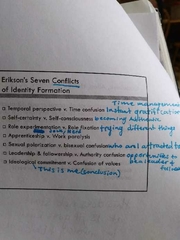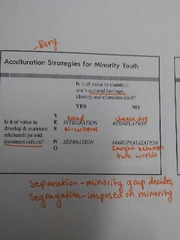![]()
![]()
![]()
Use LEFT and RIGHT arrow keys to navigate between flashcards;
Use UP and DOWN arrow keys to flip the card;
H to show hint;
A reads text to speech;
49 Cards in this Set
- Front
- Back
|
Margaret Mahlers Separation-individuatuon process |
The "psychological birth" takes place 2-3 yrs old. Separate but in relation to otgers |
|
|
Self-recognition |
Perception of slef as a separate being, distinct from others. Rouge experiment. |
|
|
Self-concept |
Categorical(4-7)-I have blue eyes Comparative(8-11)-I'm bigger than most boys Interpersonal(12-15)-im blonde which is good because most boys like me |
|
|
Social comparison |
Upward - goal of self improvement, "I don't run as fast as them, I need to do better" Downward - self-protection, want to feel better about themselves "I run way faster then them" |
|
|
Dimensions of teens self concept |
Abstract and idealistic Fluctuating Differentiated -real self -ideal self -possible self -false self |
|
|
Self-conscious |
What do people think of me? Need more privacy |
|
|
Self-esteem |
The affective component of the self "how do I feel about myself?" Ones general and specific positive and negative self-evaluations |
|
|
Baseline Self-esteem |
Feelings are stable over time, average level drops in the transition to adolescence |
|
|
Barometric Self-esteem |
Temporary changes in feelings about self that occur in response to particular incidents. Swings wider and more frequently in adolescence. |
|
|
Domains of Self-esteem unique to adolescence |
Close friendship Romantic appeal Job competence |
|
|
Predictors of Self-esteem |
#1. Physical appearance #2. Social acceptance |
|
|
Autonomy |
Dev. of the self is influenced by and emerges from interactions with others. Current views agree that it is balance between "roots and wings" |
|
|
Emotional Autonomy |
Individuation from parents while maintaining closeness. Develops in relationships w/parents Takes a long time |
|
|
Behavioral Autonomy |
Independent decision making- self-reliance Dev. In relationships w/parents & peers Increases w/improved ability to weigh risks & benefits Control impulses |
|
|
Cognitive Autonomy |
Independent beliefs & opinions, changes in how teens think about moral, political, and religious issues |
|
|
Autonomy in parent-teen relationships |
-Fostered in families that provide warmth, structure and demands for maturity -Undermined when parents engage in psychological control |
|
|
Ego-identity |
A conscious sense of uniqueness and an unconscious striving for continuity of experience. A feeling of being at home in one's body. Conception of the self made of values, beliefs, and goals. Choices and commitments |
|
|
Erik Erikson |
-Ego identity -identity VS. Role confusion |
|
|
Erikson's 7 Conflicts |

|
|
|
James Maria's Identity Statuses |
Diffusion Moratorium Foreclosure Achievement |
|
|
Ethnic Identity |
More salient issues for ethnic minority teens than majority teens. Attitudes and feelings toward your membership in a group. |
|
|
Aspects of Ethnic Identity |
Self identitification Sense of belonging Sense of shared values and attitudes Attitudes toward one's group Ethnic involvement |
|
|
Phinney's model of Ethnic Identity dev. |
Unexamined Ethnic Identity - diffusion/foreclosure Ethnic Identity search-- moritorium Achieved - achievement, bictultural = healthy |
|
|
Immersion VS. Emersion |
Immersion-- endorse minority views & reject majority Emersion- no longer reject majority & accept everything from one's own culture |
|
|
Ethnic Identity |
Determined by parental socialization and their particular experiences |
|
|
Acculturation |
Changes and adjustments that occur when groups of different people come into sustained firsthand contact |
|
|
Psychological Acculturation |
Distinct from acculturation, changes are in beliefs, attitudes, and behavior. Not every individual participates to the same extent or in the same way. |
|
|
Linear model of Acculturation |
Strong ties to culture of origin OR strong ties to "new" culture. Giving up culture of origin & assimilating into new culture. |
|
|
Two-dimensional model of Acculturation |
Cultural maintainace while having contact with larger society |
|
|
Strategies of Acculturation according to Bery |

|
|
|
Code-Switching |
Highly adaptive, switching back and forth between the majority and minority depending on situation. Ex: Karinna |
|
|
Ethnic Identity of Immagrants |
Foreigners show greater identification with American culture than native born. Because of idealistic attitudes. Educational status of family of origin. Believe the US is full of opportunities. |
|
|
Social Transmission Theory of Morality |
Children are taught moral standards. Learn set of rules through reinforcement and modeling. Authorities tell you what is wrong. |
|
|
Forbidden Toy |
No intrinsic basis. The toy is bad because they said so. |
|
|
Moral Relativism |
There is no way to know what is right or wrong apart from what society tells you. |
|
|
Cognitive-Development Theory or Morality |
Morality is universal. 2+2=4 No matter where you are. Not preference. You can believe different but you are wrong. Morality is prescriptive (ought) and generalizable. |
|
|
Moral Universality |
One person or society does not decide what is right or wrong for everyone else. People decide for themselves. |
|
|
Social Conventions |
NOT MORALITY. Uniformities that regulate social behavior. Legitimately vary across people, culture, time. |
|
|
Personal Matters |
NOT MORALITY. Set of actions that the individual considers to pertain primarily to oneself. Ex: hair, taste in music, friends |
|
|
Morality |
Pertains to matters of justice, equality, and the prevention of harm to others. Does not vary across people, culture, time. Basically not hurting people and being fair. |
|
|
Piagets Stage Theory |
Children's understanding of moral rules develops in several stages |
|
|
Heteronomy or "others rules" |
By the age of 5 or 6 children become aware of rules and regard them as sacred: rules come from others, cannot be changed and must be obeyed. Egocentrism & Unilateral relations of constraint |
|
|
Moral Autonomy |
Declining Egocentrism & Egalitarian Relations. Children become oriented towards cooperation & reciprocity. Think in two dimension. |
|
|
Kohlbergs Stage Level 1 |
Preconventional: motivated by reward or punishment. Self interest. Stage 1: punishment & obedience(7-) "how can I stay out of trouble?" Srage 2: instrumental orientation (7-10) "how can I get what I want" |
|
|
Kohlbergs Stages Level 2 |
Conventional: external standard of good and bad. Conformity is motivated by a desire to maintain the existing social system. Stage 3: good-boy (10-adolescence) "how can I make others happy?" Stage 4: law and order (adolescence) "how can I do my duty and obey the rules?" |
|
|
Kohlbergs Stages Level 3 |
Postconventional: no longer dependent upon the rules and values of one's group. Think of abstract principles. Stage 5: social contrast orientation (adult) "What are fair procedures for changing laws to protect indiv. Rights and needs of the majority?" Stage 6: universal principled orientation "How can I act according to my own ethical principles of justice and equality?" (a human life is more valuable than anything, no matter who. |
|
|
Bases for Morality |
Childhood-Fear&Obedience Adolescence - Conformity Adulthood-Principled |
|
|
Kohlberg VS Piaget |
Kohlberg - autonomy is in adulthood Piaget- autonomy is at 10 |
|
|
Carol Gilligan |
Got popular attention but is not supported by research. Woman reason with care orientation while men reson with justice orientation. |

